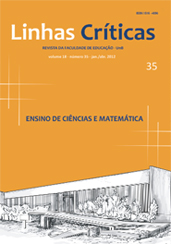Planning and design of probabilistic experiments forElementary Education I
DOI:
https://doi.org/10.26512/lc.v18i35.3845Keywords:
Statistics, Probability, Elementary schoolAbstract
We present fragments of a process of learning, learning to teach and teaching concepts ofprobability and statistics, involving teachers who work in elementary schools. This subjecthas been included in the educational curriculum in Brazil since 1998 and many workingteachers have not undergone a process of systematic learning of it in their school andworking life. One way of supporting these professionals is by publishing scientific papers.However, Guimarães et al. (2009) found that between 2001 and 2006 only seven papersrelating to this context were published. Hence, our contribution will be to reflect on theexperimentation process and its implications for learning.
Downloads
References
ASSUNÇÃO, Maria Madalena Silva. Magistério primário e cotidiano escolar. Campinas, SP: Autores Associados, 1996, v. 53. (Coleção polêmicas do nosso tempo.)
AZCÁRATE, Pilar; CARDEÑOSO, José Maria. El lenguaje del azar. Una vision fenomelogica sobre losjuicios probabilisticos. Epsilon, n. 35, p. 165-178, 1996.
______.______. PORLÁN, Rafael. Concepciones de futuros profesores de primaria sobre la nociónde aleatoriedad. Enseñanza de las ciencias, v. 16, n. 1, p. 85-97, 1998.
BARBIN, Décio. Planejamento e Análise Estatística de Experimentos Agronômicos. Arapongas: Midas,2003.
BARRERO, Antón Labraña. Azar o casualidad?: una perspectiva cultural desde la escuela. Epsilon, n. 42,p. 449-469, 1998.
BASTOS, M.S. O livro didático nas aulas de matemática: um estudo a partir das concepções dos professores.In: ENCONTRO NACIONAL DE EDUCAÇÃO MATEMÁTICA, 8., 2004, Recife. Anais. Universidade Federal de Pernambuco, 2004.
CARVALHO, Dione Lucchesi; OLIVEIRA, Paulo César. Quatro concepções de probabilidade manifestadas por alunos ingressantes na licenciatura de matemática. [CD-ROM]. In: REUNIÃO ANUAL DA ANPED,25., 2002, Caxambu. Anais. Caxambu, 2002.
COLLARES, Cecília Azevedo Lima; MOYSÉS, Maria Aparecida Affonso; GERALDI, João Wanderley.Educação continuada: a política da descontinuidade. Educação & Sociedade- Revista quadrimestralde Ciência da Educação/Centro de Estudos Educação e Sociedade (CEDES), 1999, nº 69, p. 202-219.
GUIMARÃES, Gilda et al. A Educação estatística na educação infantil e nos anos iniciais. Zetetiké, v.17,n. 32, p. 11-28, 2009.
LARROSA, Jorge. Notas sobre a experiência e o saber da experiência. Tradução de João Wanderley Geraldi. Revista Brasileira de Educação, n. 19, p. 20-28, 2002.
LÉON, Nelly. Explorando las nociones básicas de probabilidad a nivel superior. Paradigma, v. 19, n.2, p. 125-143, 1998.
LOPES, Celi Espasandin. Os desafios da educação estatística no Brasil: um olhar a partir do GT12. In:LOPES, Celi Espasandin; COUTINHO, Cileda de Queiroz e Silva; ALMOULOUD, Saddo Ag. (orgs).Estudos e reflexões em educação estatística. Campinas: Mercado de Letras, 2010, p. 47-64 (SérieEducação Estatística em foco).
______. CARVALHO, Carolina. Literacia estatística na educação básica. In: NACARATO, Adair Mendes;LOPES, Celi Espasandin (orgs). Escritas e Leituras na educação Matemática.Belo Horizonte:Autêntica, 2005, p. 77-92.
______. MORAN, Regina Célia Carvalho Pinto. A estatística e a probabilidade através das atividades propostas em alguns livros didáticos brasileiros recomendados para o ensino fundamental. In:CONFERÊNCIA INTERNACIONAL, EXPERIÊNCIAS E PERSPECTIVAS DO ENSINO DA ESTATÃSTICA:desafios para o século XXI, 1, 1999, Florianópolis. Anais... Florianópolis: UFSC/PRESTA/IASE, 1999, p. 167-174.
MAGALHÃES, Marcos Nascimento. Probabilidade e Variáveis Aleatórias. 2. ed. São Paulo: Edusp, 2006.
MOURA, Manoel Oriosvaldo. (coord.) O estágio na formação compartilhada do professor: retratos de uma experiência.São Paulo: FEUSP, 1999.
NÓVOA, Antônio. Diz-me como ensinas, dir-te-ei quem és e vice-versa. In: FAZENDA, Ivani (org). Apesquisa em educação e as transformações do conhecimento. Campinas: Papirus, 1995, p. 29-41.Coleção Práxis.
OLIVEIRA, Paulo César. O processo de aprender noções de Probabilidade e suas relações no cotidiano das séries iniciais do Ensino Fundamental: uma história de parceria. Campinas-SP, 2003. Tese(Doutorado) ”“ Grupo de Pesquisa CEMPEM/PRAPEM, da Faculdade de Educação, Universidade de Campinas (UNICAMP).
PIMENTEL GOMES, Frederico. Curso de Estatística Experimental. 13. ed. São Paulo: Nobel, 1990.
SÁENZ-CASTRO, César. Materiales para la enseñanza de la teoría de probabilidades. Madrid:ediciones de la Universidad Autónoma de Madrid, 1999.
SPINILLO, Alina Galvão. Chance estimates by young children: strategies used in na ordering chancetask. In: INTERNATIONAL CONFERENCE FOR THE PSYCHOLOGY OF MATHEMATICS EDUCATION, 21,Lahti, Finland, 1997. Proceedings. Lahti, Finland, 1997, v. 4, p. 182-189.
STEVENSON, William Joseph. Estatística aplicada à administração. Tradução de Alfredo Alves deFarias. São Paulo: Editora Harbra, 1981.
VESES, Eliseo Borras; CUBELLS, Magda Morata. El azar y su aprendizaje. SUMA, v. 3, p. 21-27, 1989.
VIEIRA, Sônia. Análise de Variância: ANOVA. São Paulo: Atlas, 2006.
Downloads
Published
How to Cite
Issue
Section
License
Copyright (c) 2016 Linhas Críticas

This work is licensed under a Creative Commons Attribution 4.0 International License.
Authors who publish in this journal agree to the following terms:
-Authors maintains the copyright and grants the journal the right of first publication, the work being simultaneously licensed under the Creative Commons Attribution License which allows the sharing of the work with recognition of the authorship of the work and initial publication in this journal.
- Authors are authorized to enter into additional contracts separately, for non-exclusive distribution of the version of the work published in this journal (eg publish in institutional repository or as a book chapter), with acknowledgment of authorship and initial publication in this journal.
-Authorers are allowed and encouraged to publish and distribute their work online (eg in institutional repositories or on their personal page) at any point before or during the editorial process, as this can generate productive changes as well as increase the impact and the citation of published work (See The Effect of Free Access).



